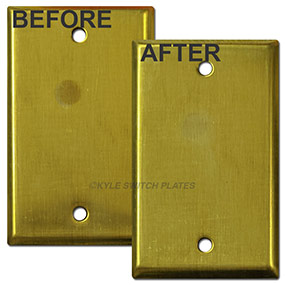Distressed Raw Brass Wall Plates - Finishing Suggestions
Popular with artists, designers, and interior decorators, unfinished brass wall switch plates have a great natural, varied look as is but also can be used to create your own special surface patina. Add a texture to the surface prior to finishing with your lacquer coating to add visual interest and character. Due to their copper content, raw brass covers are considered naturally anti-bacterial and anti-microbial.
Note that raw brass plates may start out bright or patinated depending upon the configuration and batch. These 260 brass alloy plates have no lacquer or surface finishing so may have spots, scuffs, scratches, halos, etc. The plates can be sanded, hammered, brushed, stripped, aged, burnished, or patinated as desired without the need to strip lacquer prior to refinishing the raw surfaces. (Tips for stripping lacquer off pre-finished plates can be found below.)
Cleaning Up Spots on Raw Brass Plates

Cleaning up raw brass covers is fairly easy using vinegar. It's important not to leave vinegar sitting on the cover for more than a few seconds.
There are 2 methods that work well for getting blotchy spots off of raw brass.
With both methods, use a Q-tip to apply vinegar directly to the spot. Try to keep the vinegar on the spot only and not expand into the area around it. Rub firmly into the stain. You have 2 options once the vinegar is applied.
Option 1: Blot the area with a paper towel or soft cloth (try not to spread vinegar around - don't rub a large area; just blot the stain itself). Then, reapply and blot up the vinegar as many times as necessary to get the stain lightened to your liking. Then immediately wash with a mild soap and warm water.
Option 2: Once vinegar is applied, let sit a few seconds then wash off under the faucet with warm water. Dry the plate. Continue applying vinegar and rinsing until the stain is gone.
How Can I Change the Patina on Raw Brass Switch Plates?
For a brighter finish, sand or chemically strip the patina; for a darker finish, add a patina or use an aging solution. Options for both are commercially available. We recommend searching on brass stripper, brass ager, brass darkening, brass antiquing, etc., to find a solution that matches the look you wish to achieve.
How Will Raw Brass Covers Wear Over Time?
Note that brass does not rust although it can corrode over time, especially if exposed to water or acidic chemicals, creating a tarnished or patinated surface.
Here is an example of a vintage unlaquered plate that is still installed in a 120-year-old farmhouse.
This is an example of how raw brass covers may wear over a long period of time.
How will switches look with unlacquered raw brass covers?
How Can I Remove the Finish on Lacquered Brass Switch Plates?
These unlacquered brass switchplates are available in 20 other sizes by special order. If you need additional configurations, we suggest you buy the satin brass light switch covers and try to remove the lacquer finish using a name brand product like "Klean Sweep". If that doesn't strip the finish to the degree you need, you may also try an acetone thinner. Alternately you may use sandpaper to cut through the finish.
To remove unwanted spots or tarnishing on these raw brass plates, wash with hot, soapy water or a weak ammonia & water solution.
You can also dampen a soft cloth in hot vinegar, then dip the cloth in table salt & rub the brass.
Another method is to make a paste of flour, salt & vinegar. Or, dip a slice of lemon into table salt & rub over the corroded area.
You may need several applications.
These are just suggestions and we recommend testing a single plate to see if is sufficiently stripped clean for your needs.